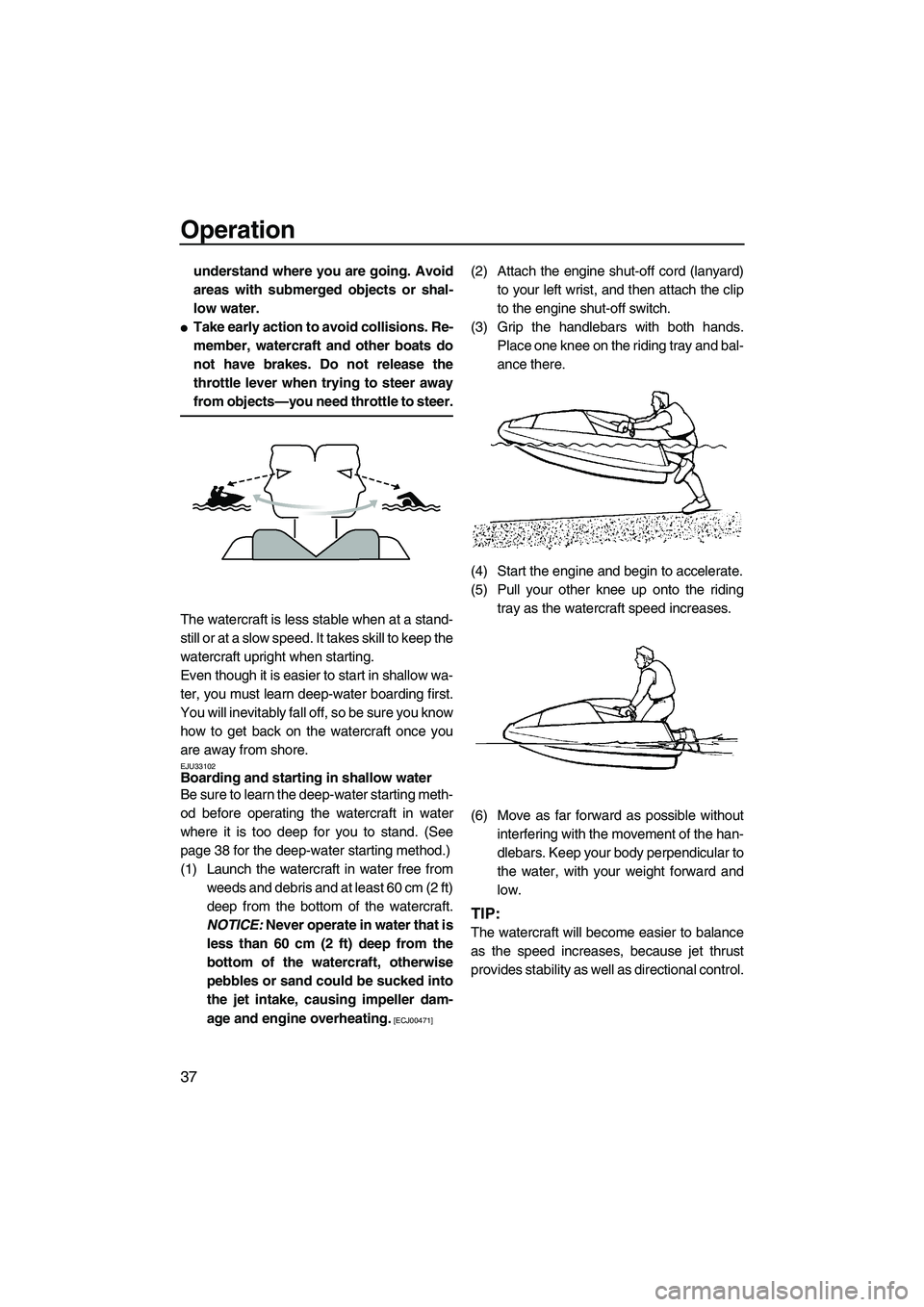Page 30 of 76
Features and functions
23
impeller. (See page 63 for checking proce-
dures.) NOTICE: If you cannot locate and
correct the cause of the overheating, con-
sult a Yamaha dealer. Continuing to oper-
ate at higher speeds could result in severe
engine damage.
[ECJ00041]
EJU31672
Storage pouch
A storage pouch is provided on the underside
of the hood for the owner’s/operator’s manual,
tool kit, and other small items.
Bend the owner’s/operator’s manual slightly
to insert it into the storage pouch, and then
add the tool kit and any other small items.
Fold the pouch, and then wrap the strap
around it. Install the storage pouch on the
hood and secure it with the bands.The storage pouch is not waterproof. If you
carry objects that must be kept dry, such as
the manual, put them in a waterproof bag.
1Storage pouch
1Band
UF2F71E0.book Page 23 Thursday, April 10, 2008 11:47 AM
Page 40 of 76
![YAMAHA SUPERJET 2009 Owners Manual Operation
33
the jet intake, causing impeller dam-
age and engine overheating.
[ECJ00471]
(3) Turn the fuel cock knob to “ON”.
(4) Attach the engine shut-off cord (lanyard)
to your left wrist, an YAMAHA SUPERJET 2009 Owners Manual Operation
33
the jet intake, causing impeller dam-
age and engine overheating.
[ECJ00471]
(3) Turn the fuel cock knob to “ON”.
(4) Attach the engine shut-off cord (lanyard)
to your left wrist, an](/manual-img/51/51310/w960_51310-39.png)
Operation
33
the jet intake, causing impeller dam-
age and engine overheating.
[ECJ00471]
(3) Turn the fuel cock knob to “ON”.
(4) Attach the engine shut-off cord (lanyard)
to your left wrist, and then attach the clip
to the engine shut-off switch. It is not pos-
sible to start the engine with the clip re-
moved from the engine shut-off switch.
WARNING! Check that the engine
shut-off cord (lanyard) is attached cor-
rectly. If the engine shut-off cord (lan-
yard) is not attached correctly, it may
not pull free when the operator fallsoff, allowing the watercraft to continue
to run and cause an accident.
[EWJ00581]
(5) Pull the choke knob all the way out to
start a cold engine.
TIP:
The choke should not be used when the en-
gine is warm.
(6) While lightly squeezing the throttle lever,
push the start switch (green button), and
then release the switch as soon as the
engine starts to run. If the engine does
not start in 5 seconds, release the start
switch, wait 15 seconds, and then try
again. WARNING! Do not apply too
much throttle when starting the en-
gine, otherwise the watercraft will ac-
celerate unexpectedly. This could
cause a collision or cause the opera-
1Clip
2Engine shut-off switch
3Engine shut-off cord (lanyard)
UF2F71E0.book Page 33 Thursday, April 10, 2008 11:47 AM
Page 44 of 76

Operation
37
understand where you are going. Avoid
areas with submerged objects or shal-
low water.
�Take early action to avoid collisions. Re-
member, watercraft and other boats do
not have brakes. Do not release the
throttle lever when trying to steer away
from objects—you need throttle to steer.
The watercraft is less stable when at a stand-
still or at a slow speed. It takes skill to keep the
watercraft upright when starting.
Even though it is easier to start in shallow wa-
ter, you must learn deep-water boarding first.
You will inevitably fall off, so be sure you know
how to get back on the watercraft once you
are away from shore.
EJU33102Boarding and starting in shallow water
Be sure to learn the deep-water starting meth-
od before operating the watercraft in water
where it is too deep for you to stand. (See
page 38 for the deep-water starting method.)
(1) Launch the watercraft in water free from
weeds and debris and at least 60 cm (2 ft)
deep from the bottom of the watercraft.
NOTICE: Never operate in water that is
less than 60 cm (2 ft) deep from the
bottom of the watercraft, otherwise
pebbles or sand could be sucked into
the jet intake, causing impeller dam-
age and engine overheating.
[ECJ00471]
(2) Attach the engine shut-off cord (lanyard)
to your left wrist, and then attach the clip
to the engine shut-off switch.
(3) Grip the handlebars with both hands.
Place one knee on the riding tray and bal-
ance there.
(4) Start the engine and begin to accelerate.
(5) Pull your other knee up onto the riding
tray as the watercraft speed increases.
(6) Move as far forward as possible without
interfering with the movement of the han-
dlebars. Keep your body perpendicular to
the water, with your weight forward and
low.
TIP:
The watercraft will become easier to balance
as the speed increases, because jet thrust
provides stability as well as directional control.
UF2F71E0.book Page 37 Thursday, April 10, 2008 11:47 AM